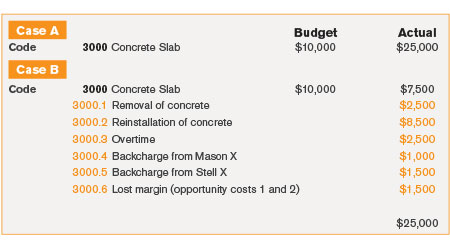
Try this exercise at your next staff meeting: Ask your employees if anyone knows the cost of rework. They might offer figures and amend them one, two or three times because, after all, if you put in the work wrong, you have to rip it out and put it back correctly. While this may be true, the final answer is never accurate. Take the following rework scenario, for example.
- Step 1. The work is installed incorrectly.
- Step 2. Demolition of the work ensues.
- Step 3. The work is installed correctly (a legitimate cost, as the work had to be installed properly at least one time).
Now, consider the opportunity costs:
- Time—While installing incorrectly, the team could have been doing something that made the firm a profit, and, conversely, while doing the demolition, the team also could have been doing something that made a profit.
- Morale—Enthusiasm takes a hit when rework must be performed, causing productivity to drop.
- Overtime—If the end date does not get extended, some of this work must be completed off hours. The firm absorbs these costs.
- Back charges—These could come in the form of the general contractor charging a trade partner for the delay or forwarding costs from other trade partners for their delay.
- Client confidence—What goes through clients’ minds as they watch demolition occurring? Do they trust you to get the project done on time and within budget when they see rework taking place?
- Liquidated damages—Money owed to you for your work may decrease as rework causes project delays, chargeable against funds owed to you, as laid out in the contract.
- Future changes—What goes through clients’ minds as they approve a change order? Does this change come with costs to “cover the hiccup?”
Pundits might argue that some of these items don’t have an actual cost. For instance, client confidence hardly reflects itself in a direct dollar figure. However, the contractor-client relationship is something that gets lost in the rework shuffle.
The above exercise was not meant to illustrate how many ways a firm can lose money, but, rather, to identify ways to mitigate the deleterious effects of rework.
Planning
Many firms still go through the motions of planning projects, work phases and trade partner work. Everyone is so focused on seeing work put in place, they forget to set themselves up for success. Some simple questions to ask your team during planning are:
- What are the ways you will win on this project?
- What is the single greatest impediment to success on this project?
- What are your mitigation strategies for said impediments?
- How would trade partners A, B and C respond to your plan?
- How informed are they about the job strategy?
Ultimately, there should be evidence of true project strategy, and leaders must vet these strategies long before the first shovel hits the ground.
Tracking
Even with the prevalence of data harvesting on jobsites, firms fail to track issues and read the early warning signs. Furthermore, the issues are only exacerbated as crews scramble to work faster in congested workspaces, sacrificing quality for completeness. If the data is telling the project team and the firm’s leadership a story, why then are they not reading it and taking appropriate action? If rework was tracked in a manner that accurately quantified the impact, would it send a different message?

The figure above shows an example of the costs of one phase of work and rework. While it doesn’t include some of the more subjective cost impacts, it does provide interesting discussion points, such as: The original slab was technically under budget, so was it rushed, or was some sort of quality assurance not followed?
Additionally, the lost margin helps demonstrate the impact to other aspects of the firm’s work. In the low-margin industry that is construction, what are you doing as a leader to help reinforce the message that losing money in any phase of operation is not acceptable?
Even at the best of firms, the punch list is the ultimate mark of rework. How many items appear on your punch lists? If you laid your punch lists out for all of the projects you completed in the last 12 months, how many repetitive items would appear? While, hopefully, none of those items would have the dollar impact of the concrete example above, it is safe to assume that there are costs.
So many firms talk about a goal of having zero punch lists but do nothing to place focus on the right behaviors/processes during the installation of the work that will hedge against long punch lists. For instance, are quality standards outlined in a preinstallation meeting before a phase or trade begins? Is that phase evaluated once it is complete? Does the firm even have a standard of what “finished” and “good” look like?
Rework is kryptonite to a contractor. Failing to plan, educate, set standards, utilize data and understand the true cost in both the short- and long-term is foolish and expensive.
